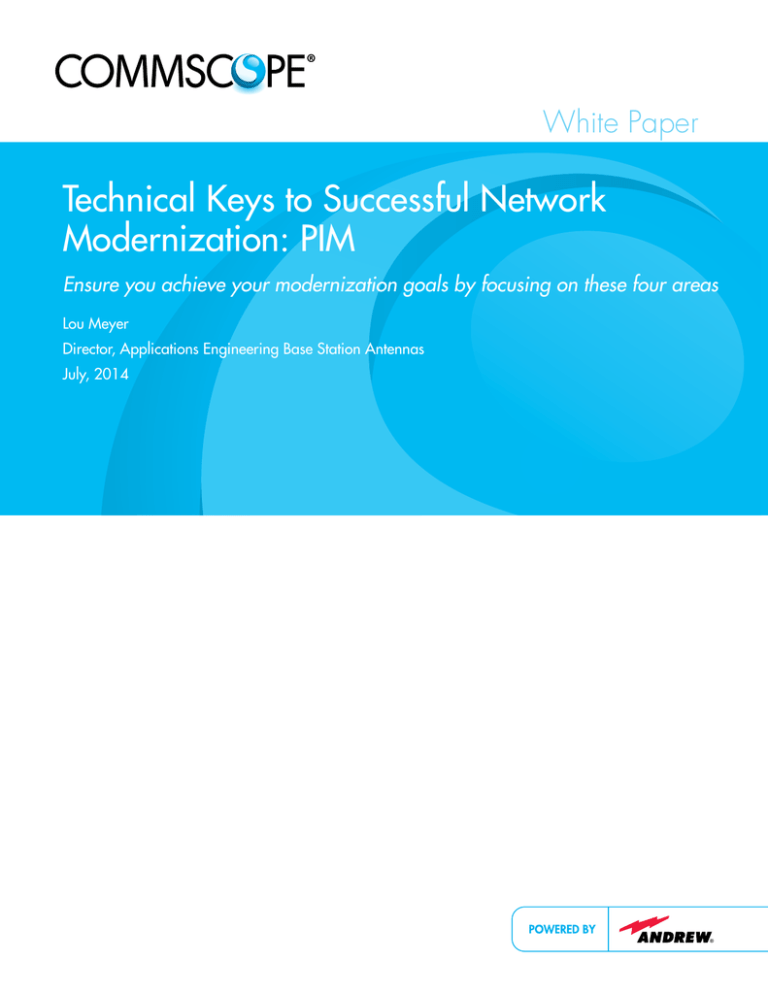Technical Keys to Successful Network
advertisement

White Paper Technical Keys to Successful Network Modernization: PIM Ensure you achieve your modernization goals by focusing on these four areas Lou Meyer Director, Applications Engineering Base Station Antennas July, 2014 Contents Introduction3 Four technical keys revisited Passive intermodulation (PIM) 3 3 PIM and component design 4 RF cable assemblies and PIM 4 Top-of-the-tower PIM challenges 5 Conclusion 6 2 Introduction In today’s competitive and rapidly growing wireless communications industry, no provider can afford to ignore pervasive and system-wide problems that impact performance—especially those that will only get worse over time as networks become more complex. One such disruptive problem that continues to grow is passive intermodulation (PIM). PIM results when two or more wireless signals mix together and create disruptive frequencies that cause interference or degrade signal transmission in wireless networks. This common phenomenon is well known in the industry and recognized by RF engineers as a real obstacle to network efficiency. And, since data usage is on the rise and network antennas and radios are more sensitive than ever to smaller levels of distortion, PIM incidents and their negative impact will become more prevalent. For example, even a 1dB drop in uplink sensitivity due to PIM can reduce coverage by 11 percent. Adding to the problem is network complexity, with each component in the RF path representing a potential source of PIM. The bottom line is PIM is a huge challenge for network operators—with the potential to impact efficiency, capacity and the bottom line. So, since PIM is such a concern, what can you do about it? What are the technical considerations—and the specific areas, components and conditions—that can cause PIM? Can tower design or even installation factors cause PIM? Most importantly, what can you do to minimize PIM in today’s congested, multi-signal environment? Four technical keys revisited All these questions give you a lot to think about. But, first, as you look to modernize your network, it’s important to look at the “big picture.” Upgrading your network is like solving a big puzzle with several key pieces. Technical Keys to Successful Modernization is a series of white papers focused on these four rather large pieces of the network modernization puzzle: •Fiber technology in FTTA solutions •Ultra-Wideband™ antennas •Weight and wind-load tradeoffs •Passive intermodulation (PIM) Each of these topics is a complex discussion, so there are four separate white papers—each focusing on a single area in the Technical Keys to Successful Modernization series. This document is the fourth in this series, where we’ll explore the issue of PIM in greater detail. Passive intermodulation (PIM) PIM is generated in a circuit carrying more than one frequency whenever nonlinearity occurs. The greater the degree of nonlinearity (the greater the curvature of the voltage/current or output power/input power characteristic) then the greater the level of the PIM signal generated. In long-term evolution (LTE) systems, PIM affects many180 kHz resource blocks which reduces cell and neighbor capacity. PIM also increases LTE intercell interference on the affected band and overall in the system. Furthermore, PIM can cause the system to operate at maximum power instead of under power control, causing undesirable increased power dissipation in the components. 3 PIM and component design The severity of PIM generation depends on the degree of nonlinear-to-linear current flow, which, in turn, depends on how well metal-to-metal contact is created at the junction. The best contact is achieved by welding, soldering, or brazing the two metal components. If doing this is impractical, there should be some means of creating high pressure across the contacting surfaces. Low or uneven contact pressure increases the proportion of nonlinear current flow and, correspondingly, the magnitudes of PIM generated. Nonlinearity at conductor joints can also be produced by the presence of corrosion. Corrosion may form over time, especially at junctions of dissimilar metals in the presence of moisture. Every component in the RF path has the potential to contribute to PIM. Common causes include: •Surface oxides •Loose metal-to-metal contacts •Surface contaminants, such as solder splatters •Contact between dissimilar metals •Improperly torqued connections •Structures or objects in close proximity to sites Identifying PIM and localizing the offending components can be difficult. Tell-tale symptoms can masquerade as an under-performing system: •Increased noise floor at the base receiver •Mobiles increase power to overcome noise •Increased uplink interference •Degraded C/I (much lower SNR) •Reduced service area •Increased rate of dropped calls •Decreased data throughput performance RF cable assemblies and PIM Wireless service providers must accommodate both conventional and fiber-to-the-antenna (FTTA) site architectures with multiple components. At the heart of it all—connecting all of the equipment you use—are your assemblies. Dozens of them. Each must deliver consistent and superior electrical performance. If even one assembly fails, the cost to troubleshoot and replace it can be steep. The integrity and quality of your coaxial cable assembly technology are crucial factors in minimizing PIM. Handling and protecting the all-important connectors—especially during the installation phase—is critical to PIM prevention. Network operators should consider pretested, PIM-certified jumper cable assemblies as front-line defenses against unwanted and potentially costly PIM. In fact, a large percentage of PIM incidents and complaints are often caused by poor-quality connector installations done in the field—often due to the lack of recommended cable preparation tools. If you need to consistently meet system PIM performance levels, eliminate installation variables, and provide long-term protection against moisture ingress and other environmental threats, consider PIM-certified cable assemblies installed by an experienced and well-equipped team. 4 Top-of-the-tower PIM challenges As discussed, there are many components that can contribute to PIM, with antennas being the most difficult to test. Older antennas were not necessarily designed to prevent PIM and can often be the root cause. There’s a reasonable expectation that most antenna technology does address PIM, but network operators should confirm that performance specifications meet this standard. Of course, the many components at the top of the tower can contribute to PIM, especially as they age or become increasingly degraded by metal corrosion. Connected parts and structures can become loosened through environmental exposure, wind and vibration. Simply put, time and elements can degrade connections in the RF signal path, causing PIM. The choice of PIM-certified components and careful, high-quality installation will help remediate these issues in the long term. Controlling PIM requires a proactive, comprehensive approach The issue and effects of PIM will only grow in importance. Although component vendors and wireless service providers appear to agree regarding PIM control during manufacturing, that same urgency and effort are not yet evident in the field. This can be seen by the number of known “good” RF components being assessed and returned as faulty. As an industry, we must do a better job of emphasizing the importance of proper connection practices and accurate PIM testing among installers and service technicians. Download the white paper Advanced wireless services emphasize the need for better PIM control now. Interested in becoming PIM and VSWR certified? Sign up for the SP6160—PIM/VSWR Certification online course through the CommScope Infrastructure Academy. This course will help you: • Understand the fundamental parameters important to wireless infrastructures, including VSWR and PIM • Learn methods for testing and troubleshooting RF systems • Explore the equipment used, and potential areas to consider, when testing a site • Understand PIM, including its effects and measurement • Learn about the test equipment available and how to conduct PIM testing • Discover key considerations for ensuring good PIM performance for different components in an RF system 5 Conclusion As you begin to tackle the issue of PIM in your network, it’s important to take a system-wide approach to solving this pervasive challenge. By definition, PIM is a system issue because it takes one passive component and two or more frequencies in the RF path to create an unwanted signal. That means it’s important to embrace a comprehensive and proactive strategy for addressing PIM—instead of waiting for network testing to indicate a problem. What’s required is a holistic approach to network modernization that takes into account all the factors that may lead to PIM. The good news is that—by taking a proactive and system-wide approach—you’ll not only minimize or avoid PIM, but also: •Increase network performance and efficiency •Reduce customer churn •Put more dollars back into your bottom line Of course, solving PIM requires partnering with a vendor that has the technical resources and expertise to help you identify and minimize PIM throughout your network. CommScope is here to help with a PIM strategy that can encompass network design, product selection, procurement, field installation and performance optimization. We can help you modernize your network with a comprehensive plan for avoiding PIM. CommScope white paper series: Technical Keys to Successful Modernization In order to meet these challenging needs, each of the four technical areas identified in the introduction of this white paper must be addressed when updating your network. They are, in fact, the four pillars of successful network modernization. That’s why CommScope has created a series of four white papers that address each of these keys individually. By addressing these technical areas, you’ll not only create a strong foundation for today, but ensure your network is ready to deploy future technologies to meet tomorrow’s demands. We encourage you to read the three other white papers in our series to get a complete view of the four network modernization keys. www.commscope.com Visit our website or contact your local CommScope representative for more information. © 2015 CommScope, Inc. All rights reserved. All trademarks identified by ® or ™ are registered trademarks or trademarks, respectively, of CommScope, Inc. This document is for planning purposes only and is not intended to modify or supplement any specifications or warranties relating to CommScope products or services. WP-107808.1-EN (6/15) 6


